There are some things that just seem to happen every year, as sure as the changing of the seasons. Among them is the fact that Apple will launch a new iPad, and that it’ll arrive on the crest of a wave of hyperbole about how wonderful it is.
Sure enough, here we are in 2018, with new iPads being launched towards the end of the year – but this isn’t the same, staid upgrade we’re used to seeing.
The new iPad Pro is not only one of the most powerful portable devices in the world, but thanks to some eye-catching design changes it’s one of the best-looking as well. Apple’s play is to take the fight to the notebook world, and its new iPad is a powerful weapon in that fight.
New iPad Pro 11 price and release date
One of the good things about an Apple event is that you know you’re going to find out when you can get your hands on the new thing that you immediately find yourself lusting after – and the painfully high cost it’s going to set you back.
The new, smaller, iPad Pro 11, which we’re reviewing here – there’s also a new iPad Pro 12.9 – will start at $799 / £769 / AU$1,229, and comes in variety of configurations. To start with you can get it in a Wi-Fi-only version, or with a cellular connection to allow you to access 4G data on the go.

Then you’ve got a variety of storage capacity options, so let’s break down the pricing. That starting price above is for the Wi-Fi-only version with 64GB of storage on board.
The next storage size up is 256GB, which starts at $949 / £919 / AU$1,449, followed by 512GB for $1,149 / £1,119 / AU$1,749. Top of the heap is the 1TB version, which costs a whopping $1,549 / £1,519 / AU$2,349.
Note that all the above prices are for the Wi-Fi-only version of the slate – if you want to add cellular connectivity you’ll need to shell out an additional $150 / £150 / AU$200.
The new iPad Pro 11 is available to pre-order now, and the release date is set for November 7.
New design

The new iPad Pro 11 (center) is the same footprint as the 10.5, but looks so much more impressive.
There’s one reason you’d pick up this new iPad: the sheer improvement in terms of the way it looks in your hands. Gone are the large, cumbersome bezels on the sides, replaced with thinner ones that more closely resemble those on the new iPhone XR.
There’s still room on the left-hand side (if you’re holding the tablet in landscape mode) for all the sensors though – Face ID, front-facing camera and so on – which are necessary so that you can actually get into the tablet without the home button.
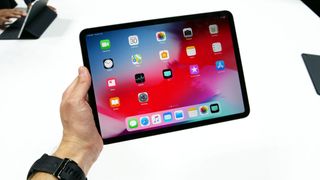
Oh, yes, that’s right: the home button is now gone from the tablet, and we can’t say we’re that bothered about its loss.
While it makes sense on a phone, where your thumb naturally falls on that spot (although of course it’s now gone from the iPhones), on a tablet it’s quite an effort to get your digit into the right place.
The smaller bezel doesn’t leave you with too little bezel to hold though – yes, you do clutch it a little more lightly, but it’s still a comfortable experience, even though the corners are less rounded.
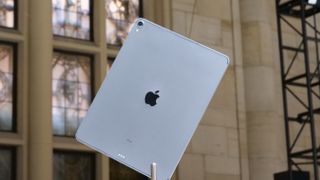
We found that using Face ID to unlock the device works much more slickly in practice, and can be used in both landscape and portrait orientations with ease.
We’ll wait for our final review unit to test this out properly, because checking it in a crowded demo area at a launch event is never going to result in the best experience.
There are a couple of other changes you need to know about. The first is that the Lightning port has gone. Yep, the ‘controversial’ port that Apple developed for the iPhone 5 is now no longer present on tablets.
Instead, we’ve now got a USB-C port, as seen on the Macbook range – according to Apple this allows you to connect an iPhone, camera or even charge other devices.
It’s an interesting move, and it does mean that you can no longer plug your iPhone cable directly into your iPad to charge it, which is going to be annoying for some.
However, given the possibilities the change of ports brings, it’ll be interesting to see what comes of it – the accessories market for Lightning connectors is geared more towards Apple’s phones than its tablets , so we can’t see this move having quite the impact that changing the connector on the iPhone would.

The other change to note is to the Smart Connector on the back – it’s moved from the long edge to the bottom of the tablet, and there are many magnets on the back to allow you to connect the new folio smart keyboard – and you can still only use the keyboard when your iPad is in landscape orientation.

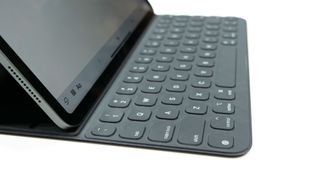
Trying the folio keyboard, it’s a very similar experience to that found on the iPad Pro 10.5 – the keystroke quality hasn’t changed much at all. There are two ‘ridges’ on it now, which allow you to prop the tablet up in different ways depending on what you’re doing.
We didn’t try the new iPad Pro on our lap, but as a desktop angle it worked pretty well.
The screen quality on the new iPad Pro 11 is, as you might expect, excellent, and has been improved upon once again by Apple.
There were few leaks about this beforehand, and overall quality has been enhanced by bringing the LCD technology from the iPhone XR – in practice there’s a real upgrade to the slickness of the display across all applications, most notably when it’s running at 120Hz for smoother gameplay.
The power inside
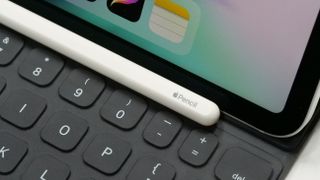
The new iPad Pro 11 is, as you might expect, one of the most powerful tablets you’ll have ever held in your hands.
Combined with the new Apple Pencil, which sticks to the side of the iPad magnetically and charges wirelessly, the new tablet has the capability to do more than any other device from Apple, thanks to using the new, upgraded A12X Bionic chip, which already eclipses the power from the iPhone XS we saw last month.


In practice, it’s hard to notice much of a change when scooting around the new iPad Pro, namely because we’ve had more than enough power to do that for a number of years.
But it’s for the heavy lifting with more power-hungry apps that Apple is touting the upgrade – there were a lot of demos where content creation was on the agenda, with full Photoshop from Adobe and console-level graphics.


We played both Pro Evolution Soccer and Assassin’s Creed on the new iPad Pro, and the level of graphical reproduction and the fluidity on the screen was very impressive – we’re looking forward to seeing whether developers actually do try and exploit the power available in the new iPad Pro or whether there won’t be the user base that wants console-level graphics on a tablet.
It’s hard not to be impressed with what the new iPad Pro can do – we’ve felt that way when looking at every new generation – but it’s debatable whether the average user will really get that much benefit from the added grunt.
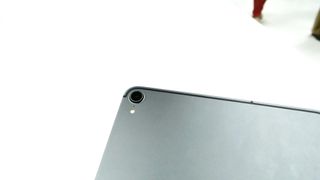
The new iPad (2018), which landed earlier this year and is now imbued with Apple Pencil support, is a much cheaper device, and does a lot of the tasks many will want a tablet for with aplomb.
But it feels like if you’re ever going to do any image or video manipulation, want to render 3D models on the go, or just feel like you want to flick between loads of projects, the iPad Pro 11 might be an upgrade worth looking at.
On the latest iPad you can even double-tap the Apple Pencil to change modes when sketching – the demo showed this off with the Notes app, and other apps like ProCreate allow you to switch between your own custom activities with a couple of taps.

It’s hard to know whether the iPad Pro is the right device for even the ardent Photoshop user – is the Pencil getting in the way of what you’re trying to manipulate going to make using it harder, or is it more intuitive than using a Wacom tablet?
Camera and battery
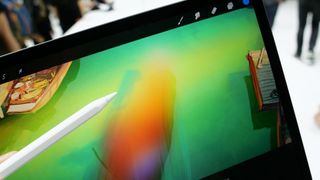
As you might expect, we’re never going to be sold on the capabilities of a tablet as a top-notch camera – unless you’re using it for field work, we say that you should never actually use it in that capacity, ever, just to stop yourself looking foolish.
However, Apple has stuck a powerful single sensor on the back on the New iPad Pro 11, bringing with it 12MP and better low-light capabilities than tablets of a few years ago.

For other situations, we get that the camera on an iPad is more important these days, for things like augmented reality, or being able to capture key information in education or outside work, and having something half-decent on there makes sense.

The 7MP front-facing camera inherits all the power of the iPhone’s TrueDepth snapper, and can even take Portrait photos using the TrueDepth camera, allowing you to blur out the background.
If you’re alone and need a large screen to check yourself out in, this isn’t a bad option, we found.
It’s also perfectly usable as a video-chatting camera (especially as there’s now Group FaceTime on offer with iOS 12.1), and that’s where we see the most use coming from the snapper on the front.
The sound quality on the speakers is now more impressive too, with a woofer and a tweeter array in each of the four corners – and it’s even more impressive given the thinness of this device, and the fact that the sound from recent iPads Pros was already good.
In the demo area we were in, the volume was so hard it was tricky holding a conversation, but still we could make out and literally feel the vibration from the new iPad Pro – we’re looking forward to trying that out in our full review.
The screen can’t display HDR content, although it can play it back (whatever benefit that has) – in the very short demos we saw the quality was good though, and given the recent iPad Pro screens were good this wasn’t a problem at all.
As an accomplished multimedia unit, the iPad Pro 11 has all the necessary elements – and although the screen is smaller we can’t see an issue with using it as a primary movie-watching machine with the family when all clustered on the bed.
Early verdict

We’ve been wondering about the iPad Pro range for a while now – whether that raw power really does make this device a laptop replacement, or whether it’s something else.
We’ve tried to use previous iPad Pros as a stand-in for an actual laptop, but there’s always some app, or mobile version of a webpage, that trips us up; and no matter what people say, the touchscreen still pales in comparison to a mouse in many situations.
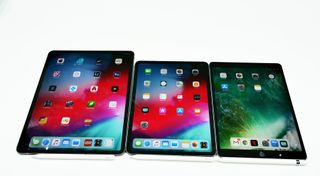
That said, the new iPad Pro 11 could be viewed differently, as a tablet that’s designed to enable creators with raw power and a sumptuous design. And maybe it’ll also attract people who just want a nicer-looking tablet, and need a reason to upgrade.
Like previous tablets from Apple, and the market in general, it’s hard to call this a ‘must-have’ device, especially with this year’s ‘basic’ iPad performing so well. But there’s a lot to be impressed with on the new iPad Pro 11, and if you’re tempted then we urge you to trot to your Apple Store to take a closer look.
